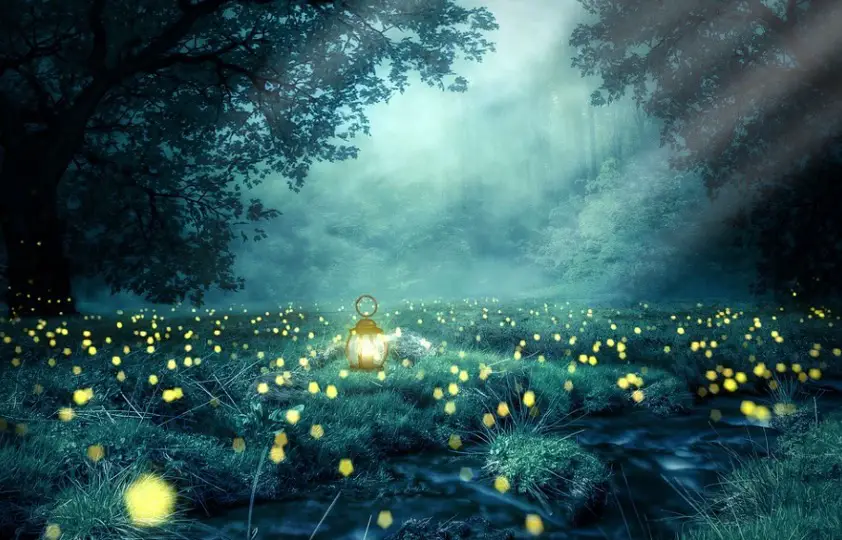Table of Contents
Glowworm: All You Need To Know
A glowworm is a variable, often a detritivore or fungus feeder, that belongs to the kingdom of Animalia, phylum Arthropoda, with several different classes. It has many different genera and species. Its length and weight are variable. Its habitat varies by species, but it is often found in caves. Its lifespan is unknown.

What is Glowworm?
Glowworms are enthralling creatures. In reality, “glowworm” is a popular term for a variety of insect species that use bioluminescence to shine. Glowworms are beetle species from four distinct families, as well as Fungus Gnats from numerous genera.
While people say Glowworm, they usually mean a genus of Fungus Gnat (Arachnocampa) that glows blue/green when in the larval stage. These insects are incredible in that they drape slime strings all around their nest. They release light from their abdomen, which is designed to attract insects, thanks to bioluminescent chemicals in their bodies. (This is why the genus name “arachno” means “spider.”)
Even little sources of light can attract a large number of insects in the dark caverns where these insects reside. Insects always become tangled when they fly into the tangled mess of sticky fly-traps. Each caught bug is simply reeled into the mouth of the larval Glowworm, and supper is served! This species’ larvae grow into big flying insects.
Why Do Glowworms Glow?
While they are the most well-known and well-known Glowworms, many other insect species generate a glowing light while they are in their larval stage. Unlike Arachnocampa worms, however, not all Glowworms consume other insects. Fungus is a food source for several Fungus Gnat species (as their name implies). Other “Glowworms” are just the larval stages of certain beetles.
Each species of Glowworm may have developed its bioluminescence for very different reasons, and they may not even be related. Bioluminescence is used by some animals, such as the Arachnocampa, to attract and collect insects. Other species may be enticing mates, warding off predators, or attracting other insects to aid in the spread of the fungus they consume.
Fun Facts About Glowworm!
Glowworms are interesting animals, thanks to the biological principles that enable them to live. Glowworms are an excellent starting place for learning about several very essential biological processes!
Bioluminescence
Biological molecules absorb energy and emit it as light, which causes bioluminescence. The structure of some biological molecules allows them to absorb energy from a variety of sources. This molecule is a protein that is triggered by ATP in the case of many insects.
When ATP gives these molecules energy, they slowly release it at a particular wavelength. The structure of the molecule determines the wavelength emitted. As a result, depending on the bioluminescent chemicals it generates, each kind of Glowworm emits a slightly different hue.
Bioluminescence is seen in many different species in nature, ranging from fungus to fish. Bioluminescence has a variety of uses, but most are linked to enticing food, repelling predators, or locating partners in extremely dark environments.
Predatory Worms and Larvae
Although the thought of a predatory worm may make some people’s skin crawl, it is a relatively regular occurrence in nature. The most frequent image of a “worm” is of a typical garden Earthworm. It’s completely safe, albeit a little slimy.
In nature, however, if a niche is open, the most numerous species usually fills it. The earthworm is a true worm that belongs to the Phylum Annelida. However, this phylum also includes a number of enormous predatory worms with hideous-looking teeth that are employed to catch and consume prey.
Because they hunt using a sticky thread, Fungus Gnat Glowworms that are active predators are really considerably fewer. Few insects have evolved equipment for trapping flying insects from a fixed position, with the exception of spiders. Nonetheless, many larvae have established predatory habitats. Aquatic insects and even tiny fish are aggressively hunted by dragonfly larvae. Antlion larvae construct ant and other tiny bug traps in the sand.
Common Glowworm Names vs Scientific Names
The term “Glowworm” is only a nickname. It can refer to a variety of different species depending on where you are. If someone mentions Glowworm in New Zealand, you have to presume they’re referring to a member of the Arachnocampa genus. They may be referring to any number of luminous beetle larvae if you’re in the United States.
As we begin to investigate and build a more comprehensive knowledge of life on Earth, scientists have devised scientific names for creatures to prevent this disaster. Common names are insufficient to describe the enormous diversity on our planet. The name “Glowworm” refers to hundreds of distinct kinds of glowing insects and does not have a universal meaning. It’s for this reason that scientists must use scientific names!
Glowworm Citations
- New Zealand glowworm (Arachnocampa luminosa) bioluminescence is produced by a firefly-like luciferase but an entirely new luciferin. Sci Rep . 2018 Feb 19;8(1):3278.
- Circadian regulation of bioluminescence in the prey-luring glowworm, Arachnocampa flava. J Biol Rhythms . 2008 Aug;23(4):319-29.
- Detection of light and vibration modulates bioluminescence intensity in the glowworm, Arachnocampa flava. J Comp Physiol A Neuroethol Sens Neural Behav Physiol . 2016 Apr;202(4):313-27.







